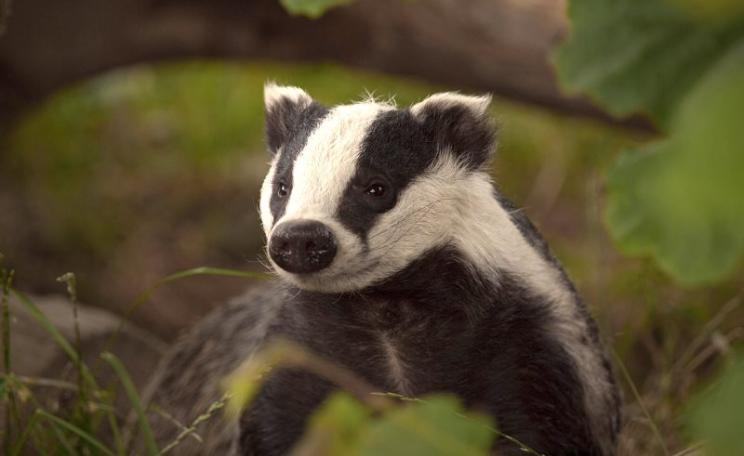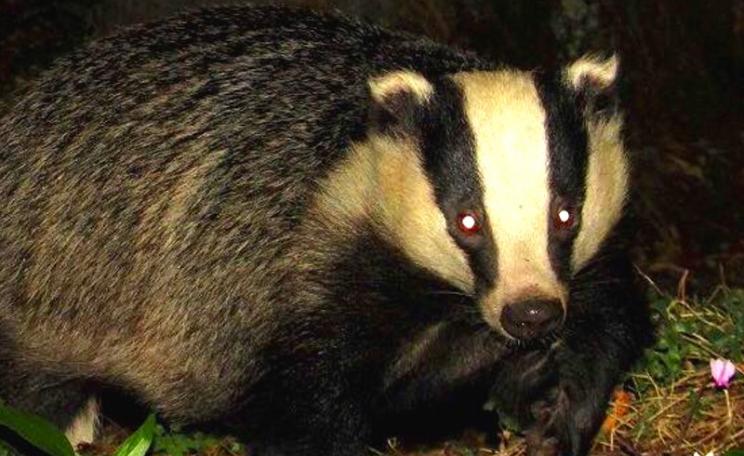It's about the cattle, much, much more than it's about the badgers. Contented cow at Three Cliffs Bay, Penmaen (near Swansea), South Wales. Photo: Mélanie via Flickr.com.
In many ways what is being achieved in Wales mirrors what happened in GB during the Area Eradication Strategy (AES) of the 1950's, 60's and 70's.
In Wales the number of cattle slaughtered due to bovine TB has nearly halved in just 4 years, from 11,671 in 2009 down to 6,102 in 2013.
This major decline of 48% since 2009, in the number of cattle slaughtered per year, has been achieved using solely cattle based measures.
Wales has not culled any badgers to achieve this result and the vaccination programme, introduced in 2012, has yet to take effect.
So how is Wales so effectively tackling bovine TB?
Since 2008 the Welsh Government has introduced a package of measures designed to identify and remove infected cattle from the national herd and to ensure that the disease is not re-introduced. The main controls that have been deployed are:
- Annual testing of all cattle throughout Wales introduced in 2008 and maintained since then
- Zero tolerance on overdue tests
- Movement restrictions
- DNA tagging of infected animals to ensure the correct animals are sent to slaughter
- Setting up Intensive Action Areas to advise farmers on bio-security and best practice to reduce disease spread and keep disease out of the herd.
What has Wales done and when?
Starting in 2008 the Welsh Government carried out a TB Health Check to test all the cattle herds in Wales for bovine TB. When this was completed in 2009 the number of overdue tests was greatly reduced and they had a much better understanding of the overall disease picture.
This major testing programme established for the first time a much clearer indication of the disease incidence across the country. Up until this point, as different areas were subject to different testing intervals, it was impossible to obtain an accurate base line of the disease presence at any given time.
This increased surveillance identified and removed a significant backlog of infection and resulted in the removal of 11,401 infected cattle in 2008 and 11,671 in 2009 from the national herd.
Also in 2008, the Welsh Government established three Regional Boards to consider the best way of tackling the disease in each area.
2009 - faster action on Inconclusive Reactors
This was followed in 2009 by a change in policy on Inconclusive Reactors which resulted in many potentially infected animals being removed from farms sooner than had previously been the case.
In addition the time taken to remove Reactor cattle was reduced down to 10 days to get infected stock off farms more quickly before there was chance for more infection to be spread.
2009 also saw the introduction of a bio-security Intensive Treatment Area (ITA) in North Wales, a region with a low record of disease incidence.
The aim of the ITA was to raise awareness and understanding of bio-security and encourage the take up of measures to prevent disease being brought on to farms.
2010 - annual surveillance
In many ways what is being achieved in Wales mirrors what happened in GB during the Area Eradication Strategy (AES) of the 1950's, 60's and 70's.
By 2010 all cattle herds in Wales were subject to an annual surveillance testing regime and pre-movement testing for bovine TB became mandatory across Wales, apart from a few exemptions.
Also in 2010 an Intensive Action Area (IAA) was set up in North Pembrokeshire, an area of high disease incidence. This introduced a six month surveillance testing interval and also increased pre-movement testing requirements, together with bio-security advice and support.
Veterinary Improvement Notices, were also introduced which gave the Welsh government the legal powers to issue cattle keepers with a notice to take certain actions to reduce the risk of spreading TB either within their own herd or to others.
As a result, compensation payments to cattle keepers who did not adhere to regulations, did not follow advice provided in their Improvement Notices or allowed their TB test to become overdue, could also be reduced.
2011 - DNA tagging of reactor cattle
The measures were further enhanced in 2011 when DNA tagging of reactor cattle was introduced.
This meant that cattle testing positive for bovine TB are DNA tagged to clearly identify reactor cattle for removal and to verify that the correct cattle have been slaughtered. This further strengthened the controls preventing spread of the disease.
The impact of the various measures resulted in a steep decline in the number of cattle slaughtered each year down from 11,671 in 2009 to 7,619 in 2010.
This was followed by a slight rise in 2011 to 8,068 and 2012 to 9,287 as the further measures introduced in 2010 and 2011 took effect, and more cattle disease was identified earlier and eliminated.
2013 - additional measures
In 2013 some additional measures were introduced which included removing approved quarantine units and also directed that the movement of cattle from TB restricted herds must be made within 30 days of a clear test.
Wales also undertook a year long project to evaluate the epidemiology of the disease within six defined 'cluster' areas. This was led by a TB field epidemiologist, who oversaw the project and made recommendations for future adoption across the wider country.
By the end of 2013, as all the control measures were in place, a substantial reduction in the number of cattle slaughtered had been achieved, with the total slaughtered for the year declining to 6,102.
This was a significant decline from the number of cattle slaughtered in 2012, which was 9,287, and was a fall of 34%. The decline in disease incidence was also reflected in the reduction of the number of new herd incidents which fell 22% in 2013 from the 2012 figure, from 1,112 down to 868.
What can England learn from the Welsh example?
In many ways what is being achieved in Wales mirrors what happened in GB during the Area Eradication Strategy (AES) of the 1950's, 60's and 70's.
With the AES a high testing intensity applied across GB, combined with strict movement restrictions and rigorous bio-security resulted in a major reduction in bovine TB.
In 1959 over 11 million tests were carried out in GB. In just 4 years the number of cattle slaughtered per year was brought down from 25,571 in 1959, to 5,901 in 1963.
What the Welsh example shows is that a high intensity of testing, on an annual basis, or 6-monthly basis where necessary, coupled with movement restrictions, removing reactors quickly and effectively and ensuring advice and action on bio-security is followed, can result in the identification and removal of the reservoir of infected cattle.
Once this quantum of disease is removed there is far less disease for onward transmission. But it is vital that the testing intensity is maintained for a sufficient time to ensure emerging disease is removed at the early stage.
This is necessary because the test for bovine TB, the SICCT test (Single Intradermal Comparative Cervical Tuberculin test) has a variable sensitivity, which means that it can miss approximately 20% of infected animals which are either in the early or late stages of disease.
Adherence to bio-security practices and pre-movement testing can then help ensure that herds remain disease free, but if measures are relaxed too soon then it is likely that new outbreaks will start to occur.
It is very much to be hoped that England will follow suit
However, if Wales continues to enforce the measures now in place then further falls in the incidence of disease should follow, as they did with the AES. Indeed by 1977 there were only 764 cattle slaughtered in the whole of GB due to bovine TB.
It is very much to be hoped that the Welsh decline continues and that the good practice that they are pursuing is soon taken up in England to the same effect.
Jan Bayley is the co-ordinator of the Animal Welfare Group, an independent organisation based in Cirencester, involved in the analysis and assessment of data and material relating to animal health and welfare.
Latest figures: The figures for the 12 months ending in December 2013 show:
- For the 12 months up to the end of December 2013 there were 868 new herd incidents in Wales.
- This compares to 1,112 in the 12 months up to December 2012. This is a fall of 22%.
- For the 12 months up to the end of December 2013 6,102 cattle were slaughtered due to TB.
- This compares to 9,287 slaughtered in the 12 months up to December 2012. This is a fall of 34%
More information
- Latest statistics on the incidence of tuberculosis (TB) in cattle in Great Britain
- History of bovine TB controls




